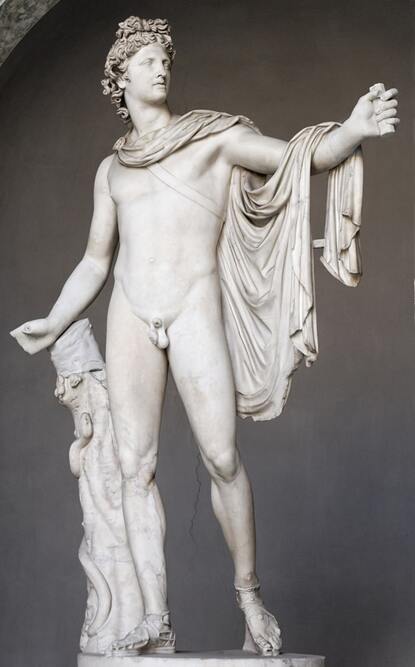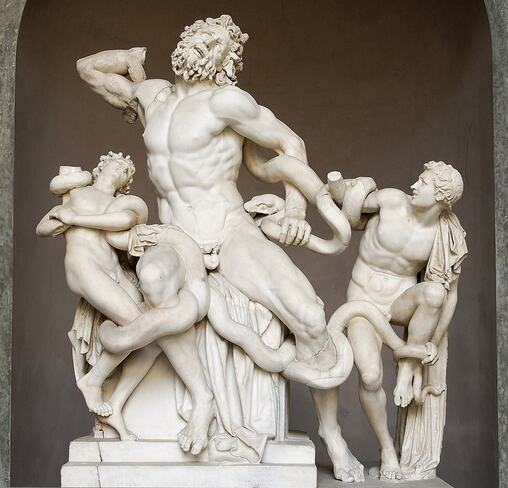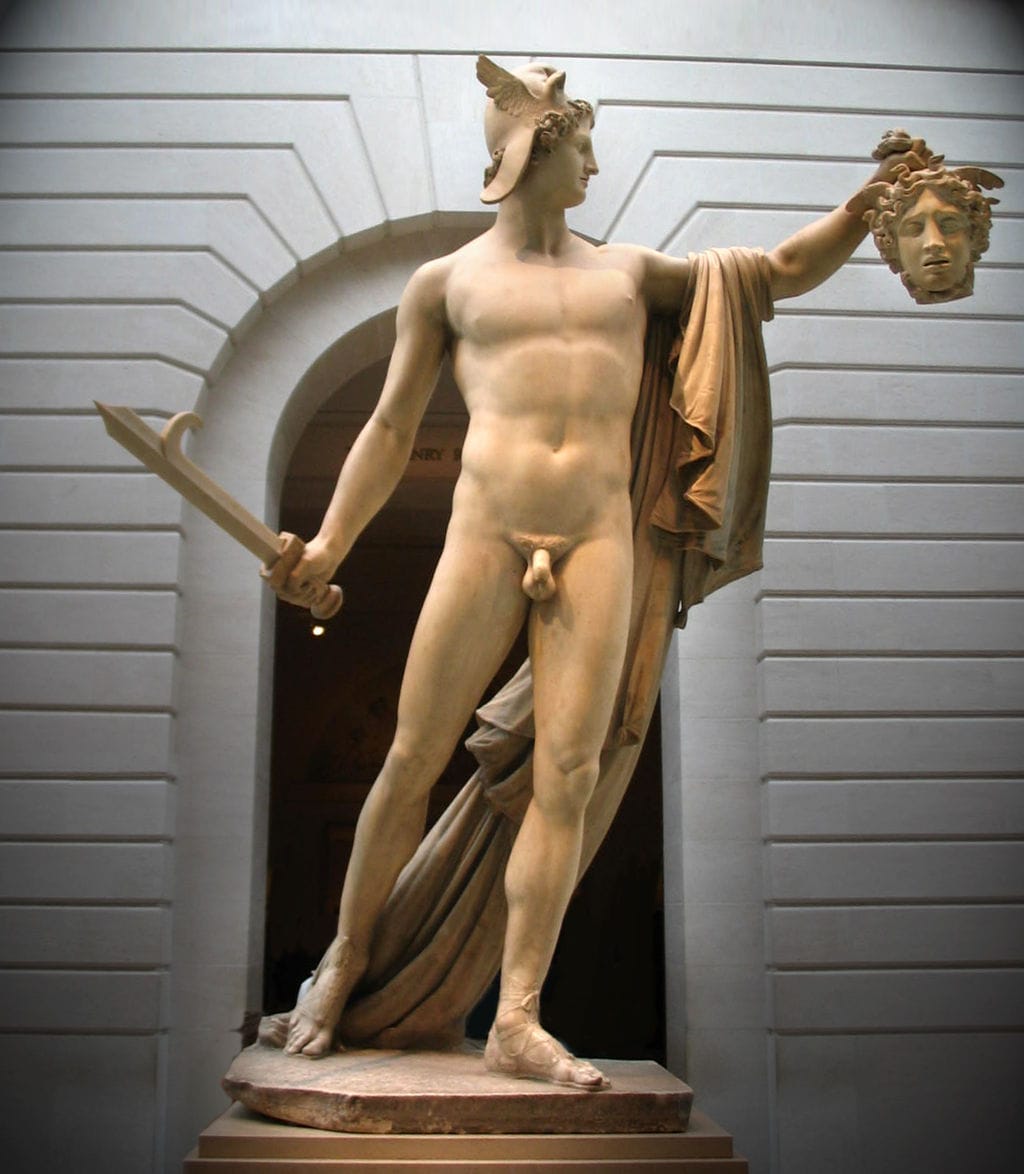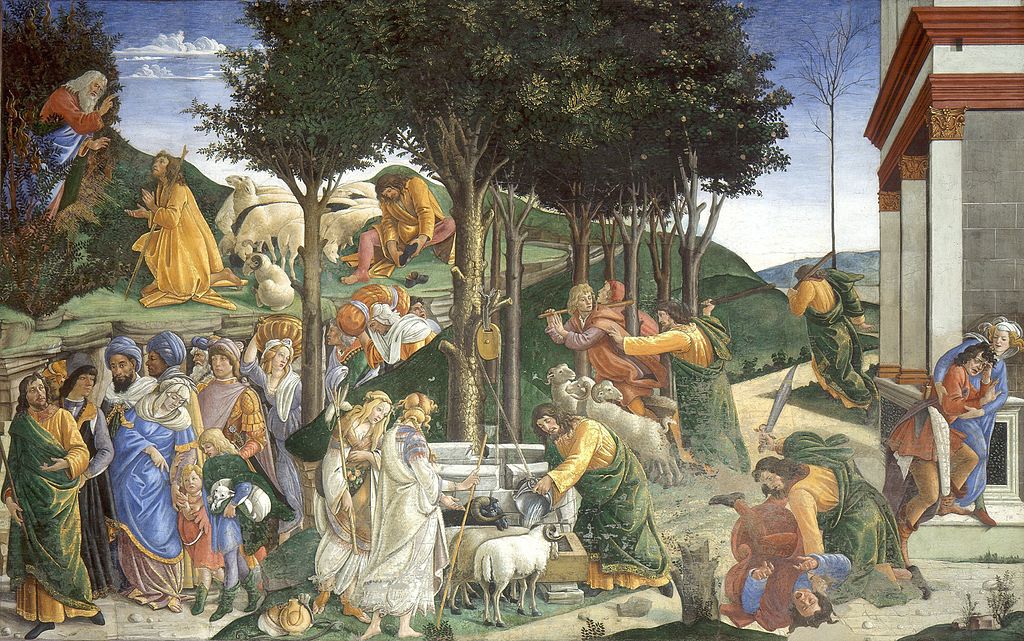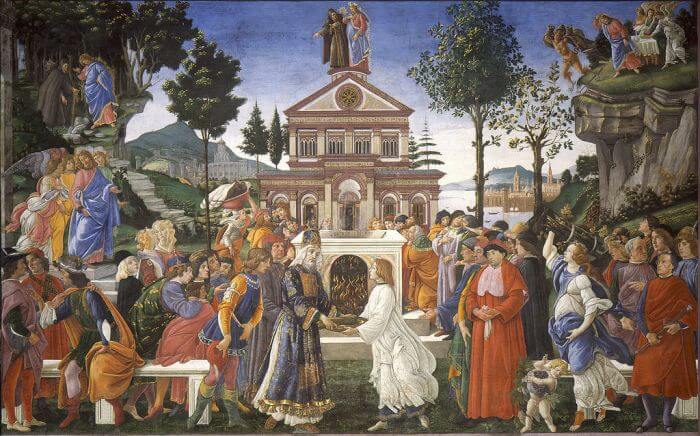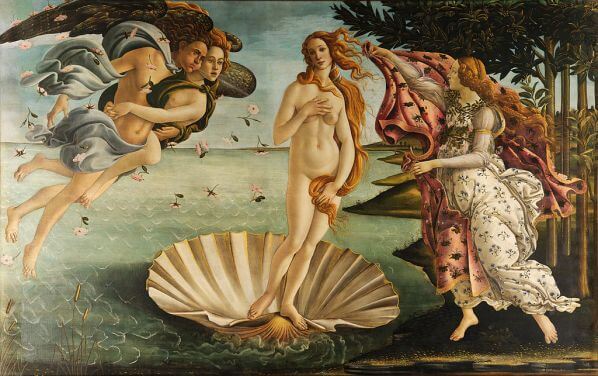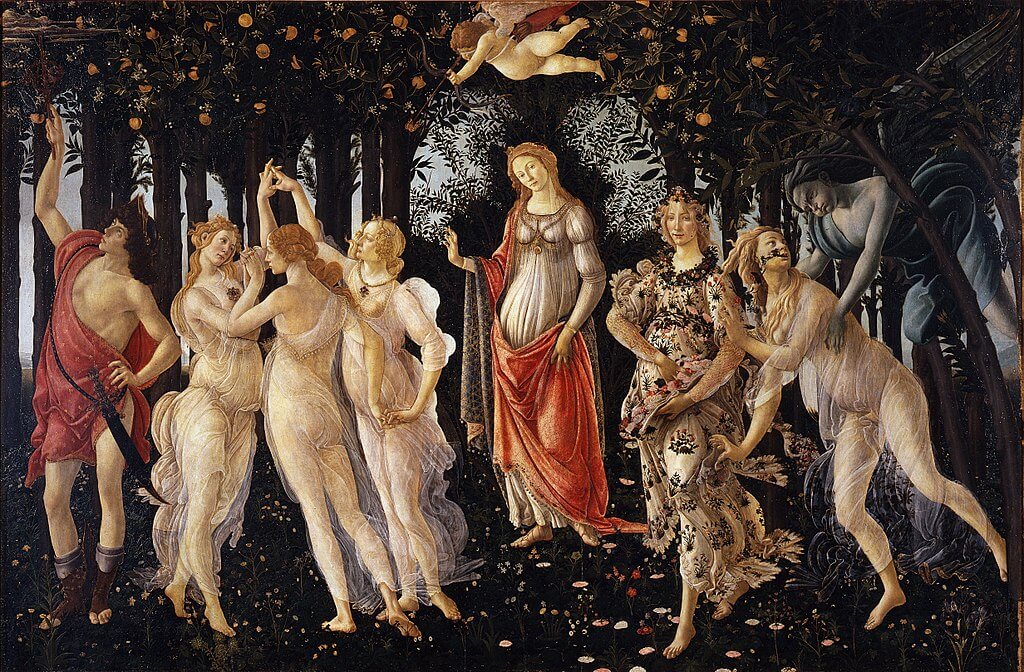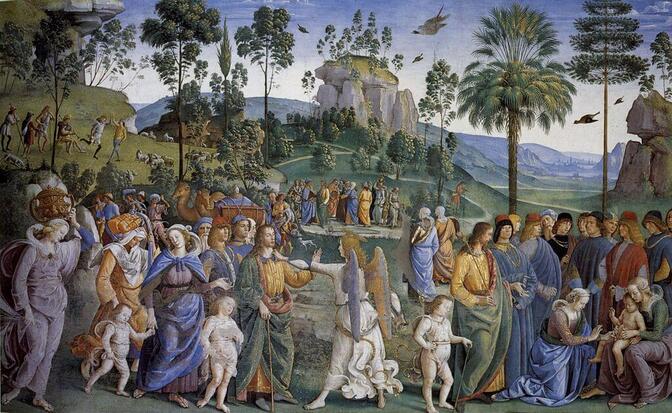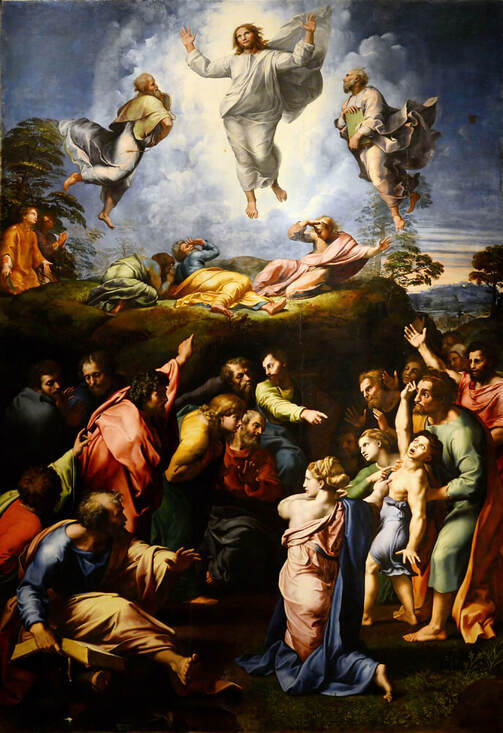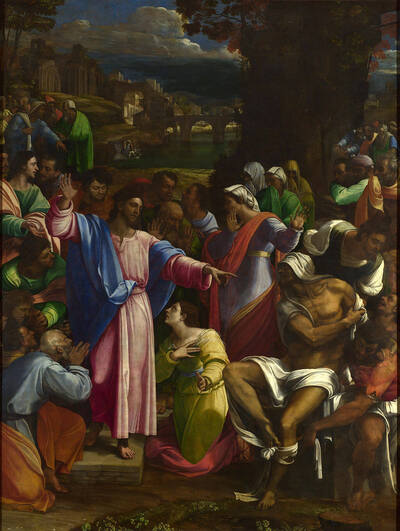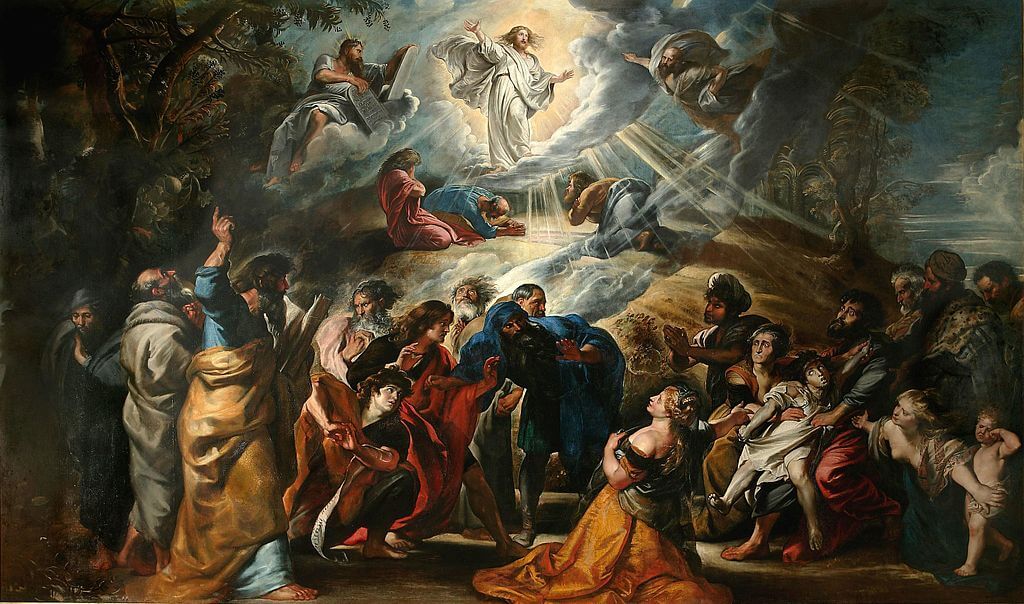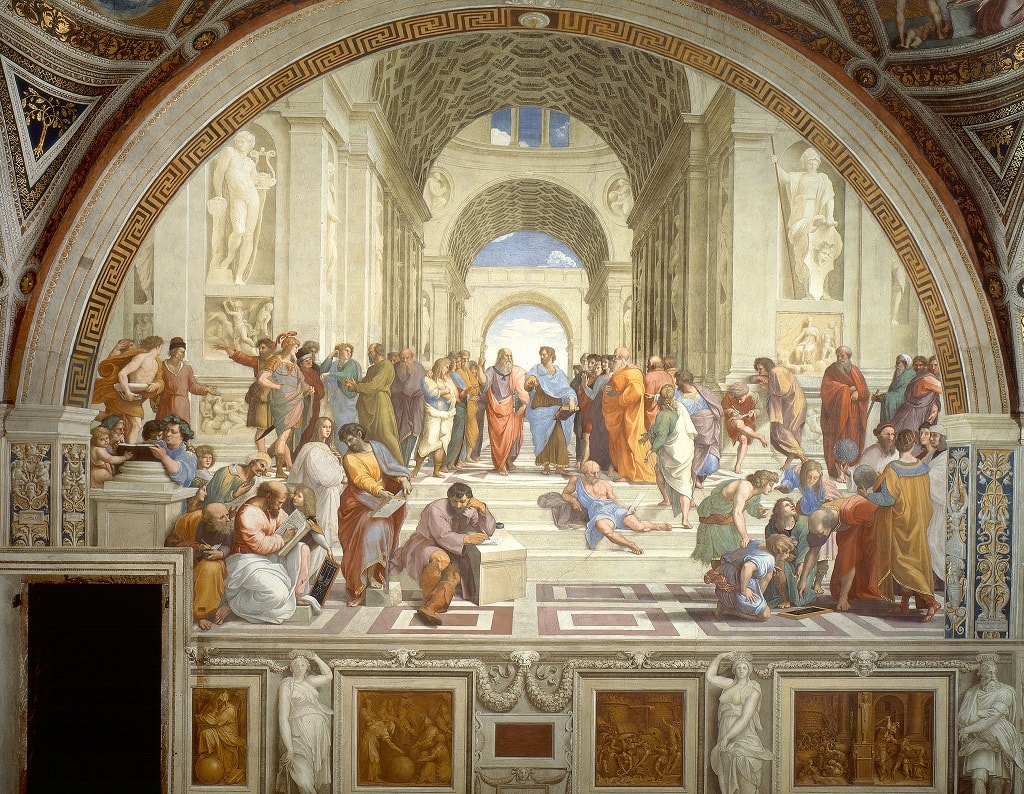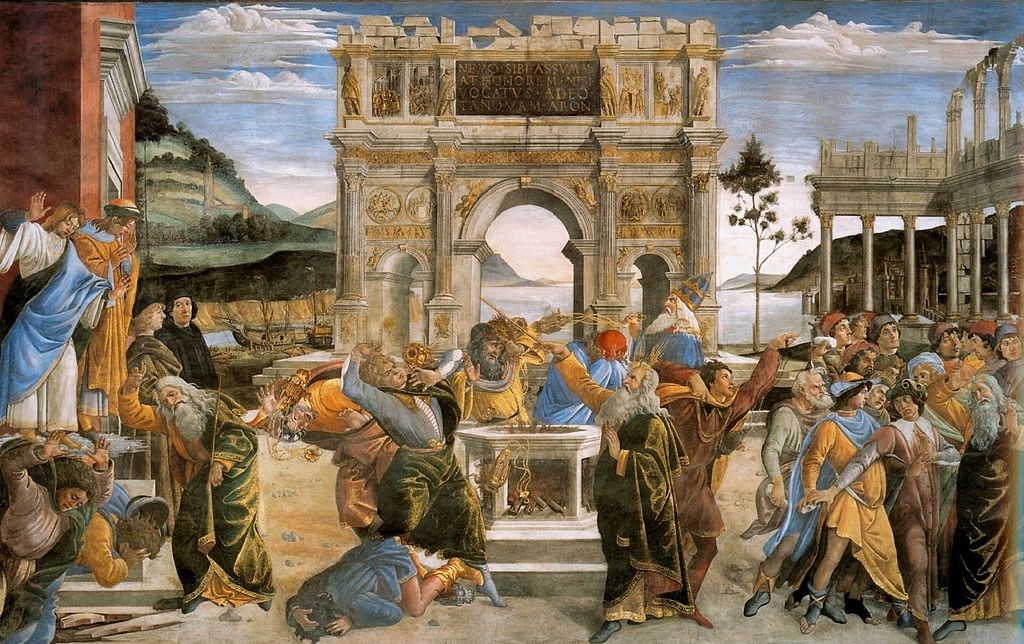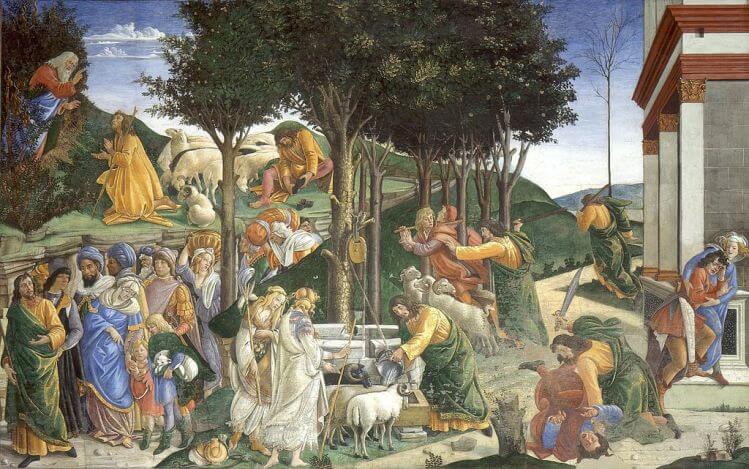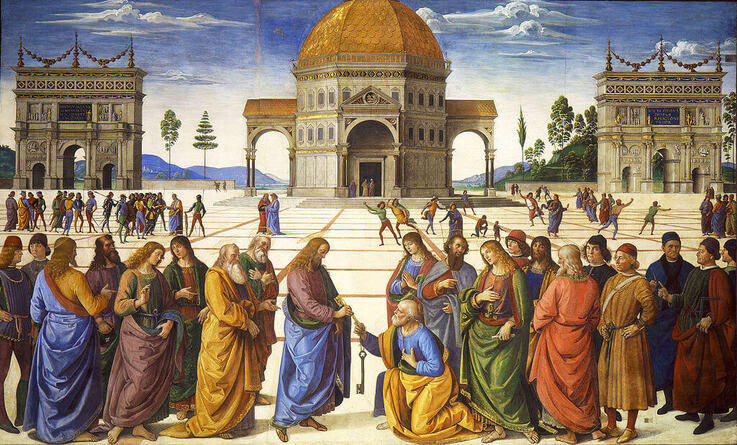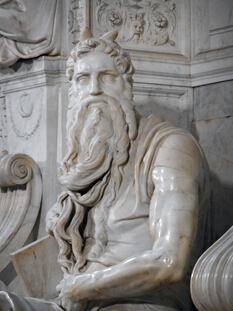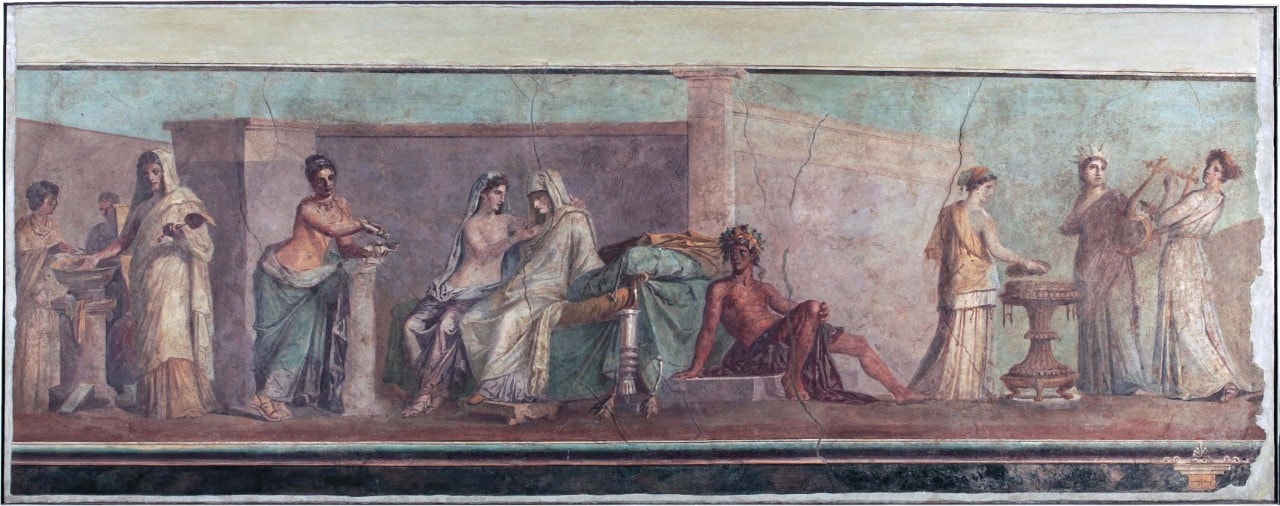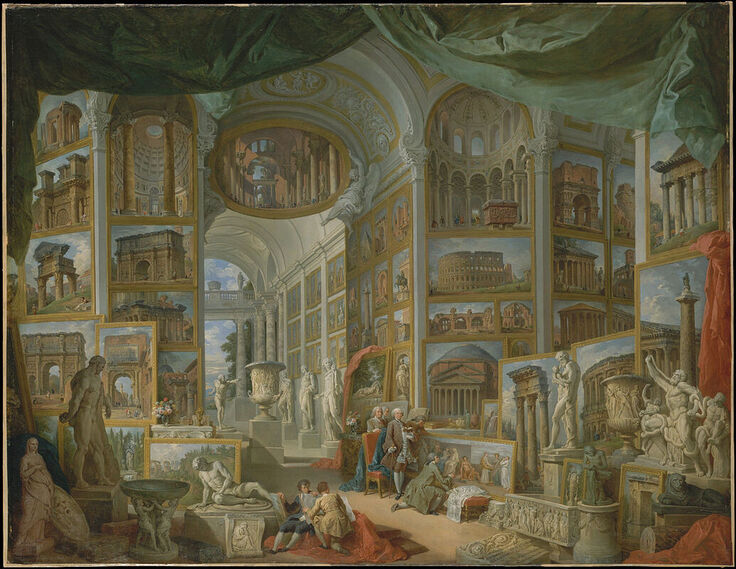|
Where? The Octagonal Court of the Museo Pio Clementino in the Vatican Museums
When? Probably between 117 and 138 AD What do you see? A marble statue of 88 inches (2.24 meters) of a beardless, athletic Apollo. The surface of the statue is very smooth. Apollo’s face shows a neutral expression. He steps forward a bit with his right leg and throws back his cloak over his left shoulder to show his fully naked body. He looks to his left and has his left arm stretched out to support his cloak. Apollo has beautiful curly hair. His hair is tied on the top with a band and his curls hang down his neck. Around his torso, he is wearing a quiver to hold his arrows. He is also wearing sandals. On the left side (for the viewer), the statue is supported by a tree trunk, and you can see a snake carved on the left side of the tree. It is not entirely clear what mythological story is depicted in this statue, though it is suggested that Apollo originally was carrying a bow and arrow. This pose may represent Apollo who has just released an arrow with the bow that he was holding in his left hand. Some people suggest that this statue represents the moment that Apollo has just killed the serpent (which is a dragon) Python. The snake on the left, which may be a python, may serve as additional evidence to support this story. Backstory: This statue has been discovered in the 15th century and is also known as the Pythian Apollo. It was probably found around 1485 in Anzio, which is about 35 miles south of Rome. This statue is a Roman copy of an ancient Greek bronze statue. It is unknown who sculpted the current version of the statue. Leochares may have sculpted the original bronze statue in the 4th century BC. Originally, the right forearm and left hand of the Apollo Belvedere were missing, but they have been restored around 1532 by Giovanni Angelo Montorsoli (a pupil of Michelangelo). Near the end of the 15th century, the statue has been acquired by Giuliano della Rovere, a great art collector, who became later Pope Julius II. The statue has been named after the Belvedere Court in the Vatican Museums where the statue was placed in 1511. It has stayed there since then, except for a period of almost 20 years when Napoleon took it and displayed in Paris. Thanks to the efforts of, among others, Antonio Canova, the statue returned to its original location. The Octagonal Court: The Octagonal Court is currently part of the Vatican Museums. The court has been designated by Pope Julius II (1503-1513) to display antique classical statues. It is an open-air court containing several famous statues from antiquity. Its name is derived from the octagonal shape of the court and was given by Pope Clement XIV in 1772. Shortly after that, the court was incorporated in the Vatican Museums and opened to the public. The Apollo Belvedere and the statue of Laocoön and His Sons are the most famous statues in this court, and both have been there from the beginning.
Who is Apollo? Apollo is the god of, among others, archery, art, music, and poetry. He is the son of Zeus and Leto and the twin sister of Artemis. In Greek mythology, he is considered to be the most beautiful man that can be imagined. A bow and arrows are his most important attributes to represent his role as the god of archery. He received these attributes from Hephaestus, the blacksmith for the gods.
However, in this statue, there are no bow and arrows, though he is wearing a quiver that usually contains arrows. He probably held the bow in his left hand. You can still see a small part of the bow in his hand, but the rest of the bow was lost before the statue was discovered. Copies and inspiration: The Apollo Belvedere has for a long time been considered as the ideal depiction of male beauty. It has been copied many times and has served as an inspiration for many future artists. For example, artists such as Michelangelo and Dürer have used it as an inspiration for their sketches and sculptures. This statue also had a big influence on the Neoclassical sculptors, such as Antonio Canova. For example, his statue of Perseus with the Head of Medusa has been directly inspired by the Apollo Belvedere. The head of the Apollo Belvedere has also been used for the emblem of the Apollo 17 lunar landing mission in 1972, which has been the last moon landing mission to date.
Fun fact: Johann Winckelmann is a famous art historian, and in his book History of Ancient Art, he poetically describes ancient art. His book also contains a description of the Apollo Belvedere. He classified the Apollo Belvedere as “the highest ideal of art” among all classic works that have survived. He classifies this statue as a beauty that transcends the beauty that we can find in this world. He admits that his words can never describe the beauty of this sculpture and looking at the statue transfers his mind to an earthly paradise.
0 Comments
Where? On the south wall of the Sistine Chapel in the Vatican Museums
When? 1481-1482 Commissioned by? Pope Sixtus IV What do you see? Seven scenes from the early life of Moses. In each scene, Moses is dressed in a yellow dress, and in five of them, he also wears a green cloak on top of it. The scenes illustrate the phases of Moses’ early life and how he became ready to become the leader of the Israelites.
The Biblical story: This fresco is based on the biblical stories as told in the book of Exodus. In Exodus 2:12, Moses kills an Egyptian man who was beating a Hebrew man. In Exodus 2:15, Moses decides to flee to Midian as the Pharaoh planned to kill him for his deed. In Exodus 2:16, Moses chases the men that were preventing the daughters of Reuel (also known as Jethro) to get water for their sheep and he helped them to give water to their sheep. In Exodus 3:5, God asks Moses to take off his sandals. In Exodus 3, Moses sees God in a burning bush, and God speaks to him and tells him that he should lead the Israelites out of Egypt. In Exodus 13:17, Moses leads the Israelites out of Egypt.
Symbolism: This painting contains many symbols, some of which are discussed below. In the scene where Moses flees from Egypt to Midian, you can see a tall tree without any leaves in front of him. This tree signifies the Tree of Knowledge to indicate that Moses will transform himself into a better person when he moves to Midian. In the scene where Moses helps the daughters of Reuel to provide water to their sheep, the woman on the left is Zipporah who Moses will marry later. She has a myrtle leave in her hair which symbolizes the conversion of a non-Jewish person to Christian faith. She also holds a spindle in her right hand (a device to spin wool into a thread), which is a reminder of the Virgin Mary. The water that Moses pours into the trough is a symbol of Baptism and the sheep symbolize the Church. In the scene on the top left, Moses has suddenly a golden rod in his hand which he received from God to lead the Israelites. Who is Botticelli? Alessandro di Mariano di Vanni Filipepi, better known as Sandro Botticelli, was born around 1445 in Florence where he also died in 1510. He spent most of his life in Florence, except between 1481 and 1482 when he painted three frescos in Rome, and an earlier period in which he spent some months in Pisa. He was an apprentice of Fra Filippo Lippi who taught him how to draw, paint, and how to create frescos. He completed various frescos during his life, but several of his Florentine frescos have been lost over time. He is best known for his framed paintings, including The Birth of Venus and La Primavera, which are both in the Uffizi Museum.
Fun fact: In the scene where Moses helps the daughters of Reuel, only two daughters are present, while the Bible mentions that there are seven daughters. The left of the two daughters is Zipporah, who Moses will marry later on. The fresco to the right of this one by Botticelli is made by Perugino and depicts Moses leaving from Midian to Egypt. In the scene on the right of this fresco, Moses is asked to circumcise his son Eliezer, who he got with his wife, Zipporah. So, while the frescos on this wall should be chronologically over time from right to left, occasionally the chronology is incorrect.
Where? Room 8 of the Pinacoteca in the Vatican Museums
When? 1516-1520 Commissioned by? Archbishop Giulio de’ Medici (who later became Pope Clement VII) for a chapel in the Narbonne Cathedral in Narbonne, France. What do you see? Two unrelated biblical events. On top is the story of the transfiguration of Christ. At the bottom is the story of a young man who is possessed by a demon.
In 1523, the painting was placed in the San Pietro in Montorio Church in Rome. Over the centuries, numerous artists and art experts considered this to be the best painting ever.
Biblical stories: The story on top is the transfiguration and on the bottom is The Healing of the Lunatic Boy. Both stories are described in Matthew 17, Mark 9, and Luke 9. The biblical story describes how Jesus is transfigured in radiant glory when praying with three of his disciples on a mountain. Jesus speaks with Moses and Elijah and also hears the voice of God. The Feast of the Transfiguration is still celebrated in many churches, either on August 6 or August 19.
The story of the demon-possessed boy occurs at the same time as the transfiguration. When Jesus and his three disciples came down from the mountain, the father of the boy kneels down in front of Jesus and asks him to heal his son as the disciples were unable to do that. In 1605, Peter Paul Rubens painted a variation of the Transfiguration.
Symbolism: The transfiguration shows the connection that Jesus provides between Heaven and Earth and that people should follow the lessons provided by the Son of God. To emphasize this, Jesus is looking upwards to the sky to remind us that he provides the connection between the people on earth and God in Heaven. The three disciples on the mountain represent faith, hope, and love. The scene at the bottom half of the painting symbolizes the inability of people to do miracles without the trust in God's abilities.
Who is Raphael? Raffaello Sanzio da Urbino (1483-1520) was a very productive painter. Despite his short life, he completed many works. Together with Leonardo da Vinci and Michelangelo, he is considered to be the most influential painter of his time. The Transfiguration is considered to be one of Raphael's best works, only surpassed according to some by his fresco of the School of Athens, which is also in the Vatican Museums. The Transfiguration was ahead of its time. It contains some elements of both the Mannerism and Baroque style of painting, and it has had a big influence on the development of both styles. With such a masterpiece, it was a pity that Raphael died on Good Friday 1520. The painting of the Transfiguration was exposed next to the body of Raphael in the days after his death, and it was initially placed above his tomb in the Pantheon.
Fun fact: The story behind this painting has been debated for centuries as it was not clear why Raphael combined two such different biblical stories in a single painting. There are many explanations, but no consensus.
A first explanation is that Raphael was competing with Del Piombo who was commissioned a painting for the same church. After he saw the completed painting of Del Piombo, Raphael decided to add additional figures to the painting to outshine the painting of Del Piombo (a protégé of Michelangelo, Raphael’s biggest rival). A second interpretation is given by Johann Wolfgang von Goethe who wrote that the painting was clearly an integrated piece. At the bottom are the people who are suffering and need the help of Jesus (emphasized by the more chaotic and dark scene) and on the top is the power of Jesus which the people at the bottom need (emphasized by the serene and bright scene). A third interpretation is that Raphael combined these two scenes because of the meaning of his name. Raphael means ‘God heals’ in Hebrew. This would explain that the disciples at the bottom could not heal the young man, but that Jesus, through the power of God, could heal him. You can pick the interpretation that you prefer. Interested in a copy for yourself? Poster or canvas
Where? On the south wall of the Sistine Chapel in the Vatican Museums
When? 1481-1482 Commissioned by? Pope Sixtus IV What do you see? The punishment of Corah (also spelled Korah), Dathan, and Abiram because they opposed the leadership of Moses. There are three different scenes:
Backstory: This painting is part of a series of frescos on the stories of Moses on the south wall of the Sistine Chapel. This series includes another fresco of Botticelli, which is Youth of Moses. The fresco on the Punishments of the Sons of Corah is based on three different stories from the Bible.
What is the Arch of Constantine? It is the largest triumphal arch in Rome. It was built to commemorate the victory in 312 AD of Roman Emperor Constantine I over another Roman Emperor, Maxentius, during a time in which there were multiple emperors in the Roman Empire. The arch is located next to the Colosseum.
The arch is 21 meters (23 yards) high and has three entrances as you can see in this painting. Roman Emperors walked under this arch when they entered the city after a victory. The Arch of Constantine is also depicted twice in the Delivery of the Keys by Perugino which is on the north wall of the Sistine Chapel in the Vatican Museums.
Symbolism: This fresco illustrates the claim of power of the Catholic Church and the papacy. It shows that only priests can perform holy duties and that God will punish people if they do not obey him. It also shows that God saves the people who obey Him. The Arch of Constantine is included to symbolize the victory of Christianity over paganism. The inscription from Hebrews 5:4 shows the holiness of the Pope as he was chosen by God.
Who is Botticelli? Sandro Botticelli was born in Florence in 1445 under the name Alessandro di Mariano di Vanni Filipepi. His father apprenticed Sandro to a goldsmith such that he could soon start making money for the family. As there was a close connection between goldsmiths and painters, Botticelli was able to become familiar with painting and discovered that this was his passion. He became an apprentice of Fra Filippo Lippi, one of the greatest painters of that time. Botticelli is best known for his famous paintings of The Birth of Venus and La Primavera, which are both in the Uffizi Museum.
Where? Room of the Aldobrandini Wedding in the Vatican Museums
When? The first century B.C. What do you see? The painting is divided into three scenes taking place in three separate areas divided by walls.
Alternative interpretations: The meaning of this fresco is subject to a lot of debate and there is serious doubt on whether this is indeed a wedding scene as its title suggests. One alternative interpretation put forward by Frank Müller in 1994 is that the fresco shows a scene from Hippolytus Stephanephoros, a tragedy written by Euripides around 428 B.C. According to Müller's interpretation, the woman dressed in white is Phaedra, a princess from Crete. She was in love with Hippolytus, the man to the right of her. Phaedra is full of guilt as she is married to Theseus (who is the father of Hippolytus). Aphrodite comforts Phaedra. To the left of Aphrodite is her daughter Peitho. On the left is a tablet standing against a pillar containing a love declaration from Phaedra. The two people on the left perform magic spells to win over Hippolytus for Phaedra as Hippolytus is not interested in her yet. On the right is Artemis, who protects Hippolytus, surrounded by two of her nymphs. This interpretation is not without problems, but one argument in favor of it is that other frescos created around the same time often show mythological stories of tragic wives. Backstory: This fresco is from the first century B.C. It is part of a larger fresco, probably a frieze near the ceiling in a retiring room in an Ancient Roman house. The fresco was discovered around 1601 in the remains of an ancient house on the Esquiline Hill (one of the seven hills on which Rome is built). Cardinal Cinzio Passeri Aldobrandini (1551-1610) came in possession of this fresco, explaining the name of the fresco, and it stayed within his family until 1818. In that year, Pope Pius VII bought the fresco from the Aldobrandini family and in 1838 it was placed on display on its current spot in the Vatican Museums. Replicas: Before the 19th century, this was one of the few Ancient Roman frescos that were rediscovered. This fresco inspired many artists to copy it, including Poussin, Rubens, Van Dyck. In 1674, Pietro Santi Bartoli created a beautiful watercolor replica of the Aldobrandini Wedding. The fresco is also featured in Giovanni Paolo Panini’s painting Ancient Rome which is on display in the Metropolitan Museum of Art, the Louvre, and the Staatsgalerie in Stuttgart.
Fun fact: The discussion about what this painting represents is still ongoing. The traditional interpretation that this fresco shows a wedding scene has been countered by various mythological interpretations. These interpretations look carefully at each attribute in the painting to understand who the different figures represent.
However, one simple argument against interpreting this fresco as a wedding is that none of the people looks even remotely happy. Especially the supposed wedding couple looks far from happy. While one may argue that the preparations for a wedding are stressful, that would still leave the question why someone would like to have a wedding scene with such serious and concerned faces on his or her wall. |
Categories
All
|
- Home
- Blog
-
Museums
- Alte Pinakothek
- Art Institute of Chicago
- Baltimore Museum of Art
- Barber Institute of Fine Arts
- Bargello
- Barnes Foundation
- British Museum
- Church of Sant’Anastasia
- Cleveland Museum of Art
- Courtauld Institute of Art
- Detroit Institute of Arts
- Frans Hals Museum
- Galleria Borghese
- Gallerie dell'Accademia
- Getty Museum
- Guggenheim
- Hermitage Museum
- Kunsthistorisches Museum
- Kunstmuseum Basel
- Legion of Honor Museum
- Louvre
- Mauritshuis
- Metropolitan Museum of Art
- Musee d’Orsay
- Museum of Fine Arts in Boston
- Museum of Modern Art
- National Gallery in London
- National Gallery of Art
- National Museum in Poznań
- Norton Simon Museum
- Ny Carlsberg Glyptotek
- Palace of Versailles
- Palazzo Pitti
- Palazzo Vecchio
- Petit Palais
- Philadelphia Museum of Art
- Prado
- Pushkin Museum
- Ravenna Art Museum
- Rijksmuseum
- San Diego Museum of Art
- Santa Maria delle Grazie
- St. Peter's Basilica
- Städel Museum
- Statens Museum for Kunst
- Tate Britain
- Tate Modern
- Timken Museum of Art
- Uffizi
- Vatican Museums
- Wallace Collection
-
Artists
- Altdorfer
- Anguissola
- Berlin Painter
- Bosch
- Botticelli
- Boucher
- Bronzino
- Bruegel the Elder
- Brunelleschi
- Cabanel
- Caillebotte
- Canova
- Caravaggio
- Carpeaux
- Cezanne
- Cimabue
- David
- Degas
- Delacroix
- De Maria
- Donatello
- El Greco
- Fontana
- Fra Angelico
- Fragonard
- Gauguin
- Gentileschi
- Gericault
- Gonzalez-Torres
- Goya
- Hals
- Hogarth
- Hokusai
- Ingres
- Leonardo da Vinci
- Lippi, Filippo
- Longhi, Barbara
- Lorrain
- Makovsky
- Manet
- Massys
- Matisse
- Michelangelo
- Mochi
- Modigliani
- Monet
- Panini
- Parmigianino
- Perugino
- Picasso
- Pisanello
- Raphael
- Rembrandt
- Renoir
- Reynolds
- Rivera
- Rodin
- Rubens
- Scultori
- Seurat
- Steen
- Tintoretto
- Titian
- Toulouse-Lautrec
- Turner
- Uccello
- Van der Weyden
- Van Dyck
- Van Eyck
- Van Gogh
- Van Hemessen
- Vasari
- Velazquez
- Vermeer
- Veronese
- Vigée Le Brun
-
Locations
- Books
- About Us

